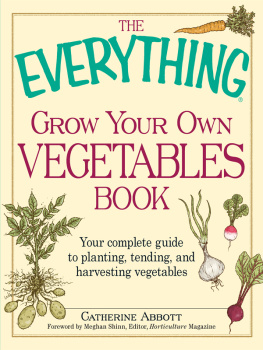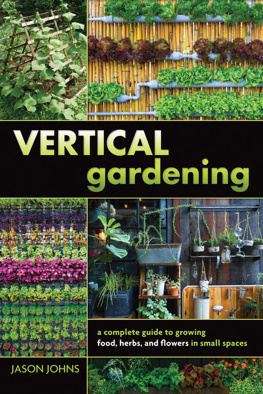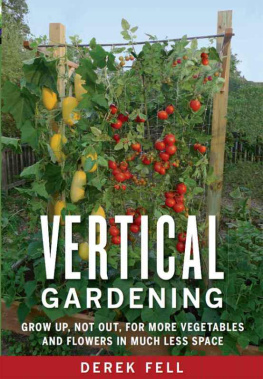THE

SMALL-SPACE
GARDENING BOOK
Dear Reader,
I am passionate about teaching and inspiring others to experience the joy and benefits of growing a food-producing garden. It was perfect timing when I was asked to write this book. I had just recently downsized, from growing veggies commercially on two acres to living in a condo with a front balcony for my only outdoor space. When I moved I immediately started growing some veggies and herbs in containers and found a new love of growing in my very small space. I was still craving a little bit more garden space and missed chatting with other gardeners, so I signed up for a 4-foot by 12-foot community garden plot. Now I have the best of both worlds: I can run out my front door to pick a handful of salad stuff for dinner, or run down the alley (yes, I created a community garden just a block away) to drop off my compost, pick some carrots or a head of broccoli, and chat with fellow gardeners. An hour or so of fun work each week is all my garden takes.
Happy creating and growing in your own small-space garden!
Catherine Abbott
Welcome to the

Series!
These handy, accessible books give you all you need to tackle a difficult project, gain a new hobby, comprehend a fascinating topic, prepare for an exam, or even brush up on something you learned back in school but have since forgotten.
You can choose to read an Everything book from cover to cover or just pick out the information you want from our four useful boxes: e-questions, e-facts, e-alerts, and e-ssentials. We give you everything you need to know on the subject, but throw in a lot of fun stuff along the way, too.
We now have more than 400 Everything books in print, spanning such wide-ranging categories as weddings, pregnancy, cooking, music instruction, foreign language, crafts, pets, New Age, and so much more. When youre done reading them all, you can finally say you know Everything!
 |  |  |  |
| Answers to common questions | Important Snippets of Information | Urgent Warnings | Quick handy tips |
PUBLISHER Karen Cooper
DIRECTOR OF ACQUISITIONS AND INNOVATION Paula Munier
MANAGING EDITOR, EVERYTHING SERIES Lisa Laing
COPY CHIEF Casey Ebert
ASSISTANT PRODUCTION EDITOR Melanie Cordova
ACQUISITIONS EDITOR Ross Weisman
ASSOCIATE DEVELOPMENT EDITOR Hillary Thompson
EDITORIAL ASSISTANT Matthew Kane
EVERYTHING SERIES COVER DESIGNER Erin Alexander
LAYOUT DESIGNERS Erin Dawson, Michelle Roy Kelly, Elisabeth Lariviere, Denise Wallace
Visit the entire Everything series at www.everything.com
THE

SMALL-SPACE
GARDENING
BOOK
All you need to plant, grow,
and enjoy a small-space garden
CATHERINE ABBOTT

Avon, Massachusetts
This book is dedicated to every reader who
wants to grow some of their own veggies, no
matter how small of a space they may have.
The Top 10 Tips for Small-Space Gardening
- Use containers for growing veggies, herbs, and small fruit trees. Containers do not require a lot of space and can be placed on balconies, patios, or hung in front porches.
- Grow vertical crops to maximize your space. Some veggies grow better if they are allowed to climb up a trellis or if they are staked. Also, vertical crops allow more space for other plants to be grown around the base of the upright plant.
- Grow plants that produce a large crop for the amount of space they take. You can get a large harvest of tomatoes or cucumbers from one plant, whereas planting a potato in the same area will not yield as much of a harvest.
- Grow plants that you can eat more than one part of. For example, with beets you can enjoy the tops as baby greens, and once the plant matures, you can enjoy the root.
- Grow intensively. Utilize the square-foot growing method to maximize the number of plants you can grow in your small-space or container garden. Just make sure you keep your soil rich and fertile to allow enough nutrients for all the plants to grow well.
- Interplant fast- and slow-growing plants. Vegetable plants mature at different times and take up different amounts of space. Intermix a variety of plants in the same spaceyoull harvest one plant while the slower growing one matures.
- Plant several different crops throughout the season. Plant an early spring crop, and once it has been harvested, remove the used plant. Replant with a summer crop, and use the area again with a veggie you can harvest in the fall or winter.
- Avoid planting too many large plants. Some plants, such as potatoes and squash, can take up a lot of garden space. Limit the number of large plants, making more room for a larger amount of smaller ones to increase your harvest.
- Choose dwarf or small-size vegetable varieties. There are several varieties of smaller vegetable plants and fruit trees being developed as more gardeners are growing in small spaces.
- Grow perpetual or perennial vegetables. Choose varieties of vegetables that can be harvested over several seasons, such as Swiss chard or kale. Grow asparagus or perennial herbs so you will be able to harvest from the plants for several years with only a little maintenance.
Introduction
VINE-RIPENED TOMATOES. SUCCULENT SQUASH. Plump cucumbers. Growing vegetables is a rewarding and cost-effective way to eat better for less, but you might think you lack the space necessary to grow a food-producing garden. With this guide, however, you will learn how to maximize your space and grow delicious vegetables, herbs, and fruits cheaply and efficientlywhether you have a small backyard or just a window sill.
Youre most likely used to seeing your backyard, front yard, or existing flower beds in a certain way and might not even realize that there may be different options for utilizing those spaces. This book will help you take a look around your property, see it with fresh eyes, and find those hidden spots that may have potential for starting a food garden. A green patch as small as a square foot can nourish and grow some lettuce plants or even a tomato plant, so long as the area gets enough sun. Once you see the potential in one area, you will be surprised how every little nook and cranny in your small space could be the next perfect spot for growing some veggies or herbs.
Even a concrete jungle with no green in sight (other than an occasional green storefront canopy) can have great possibilities for supporting food-producing areas. Both your high-rise balcony or the rooftop of your apartment or office building can sustain growing vegetables in containers or hanging baskets. Another great option for the urban dweller is to check out community gardens in your neighborhood, and if there arent any, perhaps there is a park or empty lot that would be the perfect place to start. There is so much potential for growing food no matter where you live. You just have to know where to lookand this book can help.













